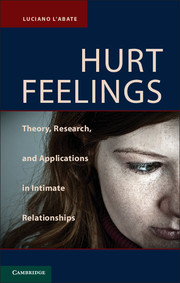Book contents
- Frontmatter
- Contents
- Preface
- Acknowledgments
- Introduction
- Part One Background
- Part Two The Scientific Bases of Hurt Feelings
- 6 The Discovery of Hurt Feelings
- 7 Biological Processes Underlying Hurt Feelings
- 8 Gender and Individual Differences in Hurt Feelings
- 9 Cultural Differences in Hurt Feelings
- 10 The Psychopathology of Hurt Feelings
- Part Three Applications of Hurt Feelings in Mental Health
- Part Four Models of Hurt Feelings In Theory and Applications
- Appendix A An Informed Consent Form to Deal with Hurt Feelings
- Appendix B Experimental Scale of Unexpressed Hurt Feelings
- References
- Author Index
- Subject Index
9 - Cultural Differences in Hurt Feelings
from Part Two - The Scientific Bases of Hurt Feelings
Published online by Cambridge University Press: 05 June 2012
- Frontmatter
- Contents
- Preface
- Acknowledgments
- Introduction
- Part One Background
- Part Two The Scientific Bases of Hurt Feelings
- 6 The Discovery of Hurt Feelings
- 7 Biological Processes Underlying Hurt Feelings
- 8 Gender and Individual Differences in Hurt Feelings
- 9 Cultural Differences in Hurt Feelings
- 10 The Psychopathology of Hurt Feelings
- Part Three Applications of Hurt Feelings in Mental Health
- Part Four Models of Hurt Feelings In Theory and Applications
- Appendix A An Informed Consent Form to Deal with Hurt Feelings
- Appendix B Experimental Scale of Unexpressed Hurt Feelings
- References
- Author Index
- Subject Index
Summary
Most research on hurt feelings has been conducted in Western cultures, with relatively little attention paid to the ways in which the experience and expression of hurt feelings might vary cross-culturally.
Kowalski, 2009 (p. 457)
Contributions about cultural factors included already in Vangelisti’s (2009b) Handbook and especially in Kowalski’s (2009) chapter will not be included here to avoid any duplication and overlap between this and those publications. There are clearly cultural differences in relationship beliefs across countries as they relate to how emotionality is experienced and expressed (Brase, Caprar, & Voracek, 2004; Goodwin & Gaines, 2004; Mesquita & Albert, 2007; Shweder, Haidt, Horton, & Joseph, 2008). Here is where Bakan’s (1968) dichotomy of communal versus agentic relationships is worth mentioning. As Spiegel (1971) indicated, there are cultures in the Mediterranean basin, such as Greece, Italy, Portugal, and Spain, that place more value on being together communally in expressive conversation than on relating agentically or instrumentally, such as in United States and other industrialized countries.
In this chapter, only cross-cultural differences will be included if they are relevant to hurt feelings either directly or indirectly. Results from studies inside a single country without cross-cultural comparisons will not be included unless they are specifically related to hurt feelings. Furthermore, there may be genetic differences in how pain is experienced. For instance, there may be physiological differences between African Americans and white Americans in how much physical pain may be experienced and endured (Campbell, France, Robinson, Logan, et al., 2008; Diatchenko, Nackley, Tchivileva, Shabalina, & Maixner, 2007; Nielsen, Staud, & Price, 2009). How these possible differences in physical pain apply to how hurt feelings are experienced, expressed, and shared culturally will be the subject of this chapter.
- Type
- Chapter
- Information
- Hurt FeelingsTheory, Research, and Applications in Intimate Relationships, pp. 204 - 213Publisher: Cambridge University PressPrint publication year: 2011



